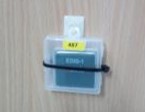There are two aspects to radiation safety:
- Radiation associated with the synchrotron itself
- Radioactive samples that might be brought to SESAME
The general principles of radiation safety is that exposure to any person should be kept As Low As Reasonably Achievable (ALARA)
- Physical radiation protection mechanisms
Most Gas Bremsstrahlung (GB) & synchrotron radiation will be found inside the closed and interlocked hutches of the beamline. Radiation levels outside the hutches are below 0.5µSv/h in all directions. Before entering any hutch, pay attention to the status of the hutch and use the emergency push button to stop the beam. For soft X-ray beamlines, no hutches are needed outside the accelerator shielding walls.

At all times you should pay attention to the status of the hutches. Inform the relevant beamline scientist or the safety office if you observe:
- Missing lead panels.
- Clear deformation in lead panels.
- Any utilities chicanes are NOT properly closed from both sides.
- Lead door not closed properly.
You are not authorized to change the status of any shielding materials.
The Personal Safety System (PSS) restricts and controls the access to forbidden areas – that is, it prevents personnel from being exposed while accelerators or/and beam lines are in operation.

 DO NOT close any hutch in the PSS without permission from the responsible beamline scientist and advance training from the control team.
DO NOT close any hutch in the PSS without permission from the responsible beamline scientist and advance training from the control team.You can enter the hutches of the beamline if and only if:
- You have completed a special training on how to use PSS of the beamline and this training is still valid.
- You are explicitly allowed to enter the hutches by the relevant beamline scientist.
- You are under supervision of the relevant beamline scientist.
- You are wearing a personal dosimeter if the machine is in operation.
- The hutch is in an OPEN state.
-
Radiation monitors
 There are area monitoring systems around the facility. These must not be removed from their position, and must not be disconnected from power or data connections.
There are area monitoring systems around the facility. These must not be removed from their position, and must not be disconnected from power or data connections.There are passive radiation dosimeters placed throughout SESAME. Do not remove these.

You will be provided with a personal dosimeter for the period of your beamtime. Terms of use of personal radiation dosimeters:
- The dosimeter does not entitle you to enter restricted areas, and does not protect you from exposure to radiation
- You must wear the dosimeter at all times at SESAME, especially when entering the main hall
- Wear on the chest, at the height level of electron beam
- Inform the safety office if the dosimeter is lost or broken
- Keep the dosimeter away from direct sunlight, water, spark sources
- Fill in the relevant form when you first collect the dosimeter
- Use only the dosimeter that has been assigned to you
- Do not take the dosimeter with you off the SESAME premises: store in the wooden mailbox each day when you leave
- If you have forgotten to return the dosimeter, kept it out of the reach of others and do not wear it when undergoing any medical radiography.
- In case of pregnancy, please inform the safety office
- Study of radioactive samples at SESAME
If your experiment involves any radioactive samples, you will be required to fill in the radioactive risk assessment at least two weeks before your visit. Users must quickly reply to any subsequent questions from the Safety Office.
Samples with dose rate (DR) > 0.5 µSv/h are not permitted. Samples with DR of 0.25 – 0.5 µSv/h are considered high risk and must be handled accordingly. Samples with radiation DR <0.25 µSv/h are considered medium risk. Gaseous and liquid radioactive samples are not permitted.

